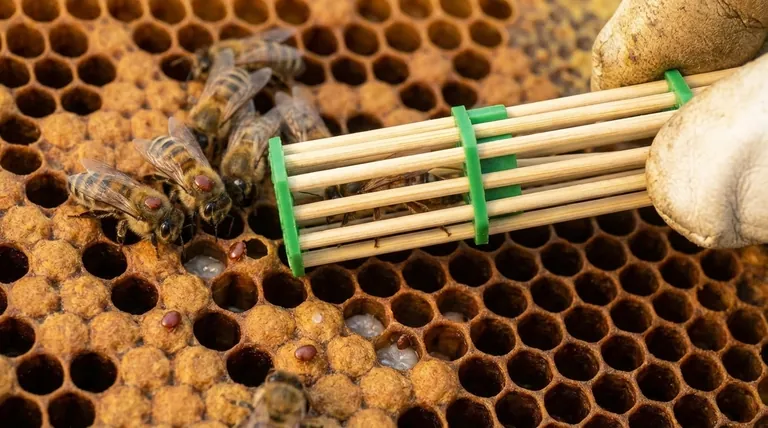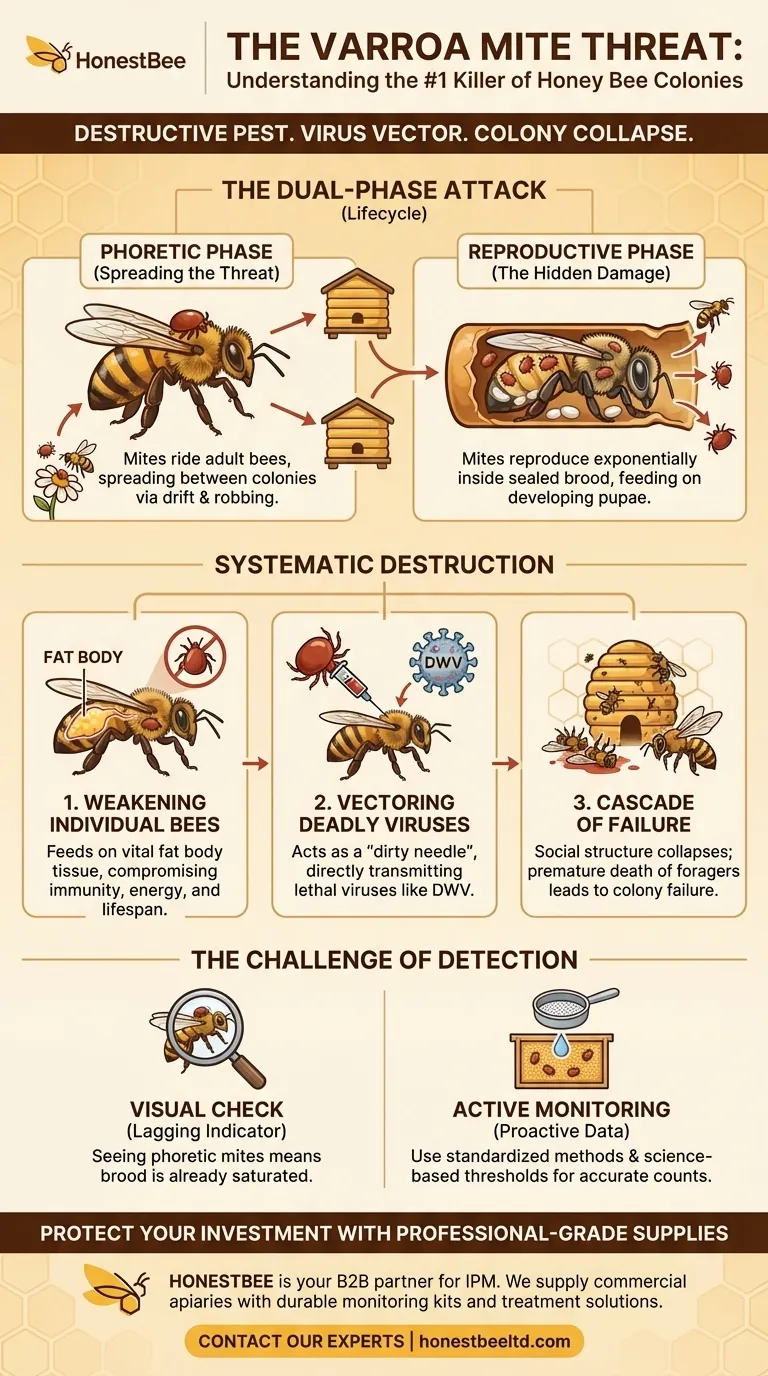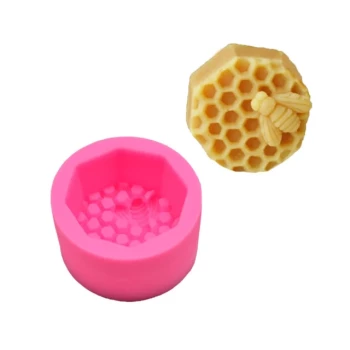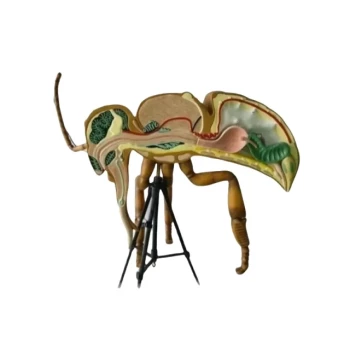Varroa mites are the single most destructive pest of Western honey bees. These tiny, external parasites attach to both adult bees and developing brood, feeding on their vital fat body tissues. This parasitic feeding weakens individual bees and, more critically, transmits a cocktail of deadly viruses that can lead to the rapid decline and death of an entire colony.
The core threat of the Varroa mite is not just its parasitic nature, but its role as a highly effective vector for lethal viruses. The mite's reproductive cycle, hidden within the hive's sealed brood cells, allows infestations to grow exponentially before a beekeeper might notice a significant problem.

The Varroa Mite's Dual-Phase Attack
To understand the mite's devastating impact, you must understand its two-stage life cycle, which allows it to both spread between colonies and reproduce rapidly within one.
The Phoretic Phase: Spreading the Threat
The term phoretic refers to the mites you can physically see on the bodies of adult bees. In this phase, a female mite is essentially a passenger, feeding on her host bee while waiting for an opportunity to reproduce.
This is the primary way mites spread from one colony to another. They travel on foraging bees that drift into the wrong hive or on bees from stronger colonies that rob honey from a weaker, mite-infested one.
The Reproductive Phase: The Hidden Damage
The real destruction happens out of sight. When a female mite is ready to reproduce, she detaches from an adult bee and enters a brood cell containing a bee larva just before the worker bees cap it with wax.
Safely sealed inside, the "foundress" mite lays her eggs. These offspring hatch, mate with each other, and feed on the developing bee pupa. By the time the young bee emerges from its cell, it is weakened, and several newly mated female mites emerge with it, ready to begin the cycle again.
How Varroa Systematically Destroys a Colony
A Varroa infestation is not a simple pest problem; it is a cascade of failures that cripples a hive from the inside out.
Weakening Individual Bees
Varroa mites feed on the fat body of the bee. This organ is critical, functioning much like the human liver. It is essential for immune response, pesticide detoxification, energy storage, and regulating hormone levels.
A bee that has been fed upon by mites, especially during its development, will be underweight, have a weaker immune system, and a significantly shorter lifespan.
Vectoring Deadly Viruses
This is the most critical function of the mite. As it feeds, it acts like a dirty needle, directly transmitting viruses into the bee's open circulatory system.
Pathogens like Deformed Wing Virus (DWV) are relatively benign in the absence of mites. However, when vectored and amplified by Varroa, they become lethal, causing the misshapen wings, paralysis, and early death that are hallmarks of a colony collapse.
Creating a Cascade of Failure
The combination of physical weakening and viral infection has a devastating effect on the colony's social structure.
Infested bees cannot perform their jobs effectively. Nurses can't properly care for the young, and foragers die prematurely, reducing the hive's income of nectar and pollen. This leads to a shrinking workforce struggling to sustain itself, a situation that often proves fatal during the winter.
The Challenge of Detection and Control
The mite's life cycle makes managing an infestation a significant challenge for beekeepers. Understanding the limitations of simple observation is key.
The "Invisible" Infestation
The most dangerous part of the mite population is hidden within the capped brood. At any given time, the majority of a hive's mites are in this reproductive phase.
Relying on seeing mites on adult bees is a lagging indicator of colony health. By the time phoretic mites are easily spotted, the brood is likely saturated, and the colony's health is already in serious jeopardy.
The Need for Active Monitoring
Because a visual inspection is unreliable, beekeepers must use active monitoring methods to get an accurate count of their mite load. This data allows them to act before the infestation reaches a critical threshold.
Management guides, such as the Honey Bee Health Coalition's Tools for Varroa Management, provide science-based action thresholds that tell a beekeeper when intervention is necessary to save the colony.
Making the Right Choice for Your Goal
A proactive stance is the only effective strategy for managing Varroa mites. Your approach should be informed by the mite's biology.
- If your primary focus is keeping bees healthy: Prioritize regular monitoring of mite levels using standardized methods to understand the true infestation level, not just what you can see.
- If your primary focus is ensuring colony survival: Implement a management plan based on established economic thresholds, treating when necessary rather than waiting for visible signs of decline.
Ultimately, understanding that Varroa's primary threat is the viruses it transmits is the first and most critical step toward protecting your honey bee colonies.
Summary Table:
| Mite Life Cycle Phase | Key Activity | Primary Impact on Colony |
|---|---|---|
| Phoretic Phase | Mites ride on adult bees, spreading between hives. | Facilitates infestation of new colonies through bee drift and robbing. |
| Reproductive Phase | Mites reproduce inside sealed brood cells, feeding on pupae. | Weakens developing bees and exponentially increases mite population hidden from view. |
| Virus Vectoring | Mites transmit viruses like Deformed Wing Virus (DWV) directly into bees. | Causes paralysis, deformed wings, and premature death, leading to colony collapse. |
Protect Your Investment with Professional-Grade Beekeeping Supplies
Varroa mites pose an existential threat to your apiary's health and productivity. Effective management requires not just knowledge, but also the right tools for monitoring and control.
HONESTBEE is your trusted partner in this fight. We supply commercial apiaries and beekeeping equipment distributors with the durable, reliable supplies needed to implement a successful Integrated Pest Management (IPM) plan. From mite monitoring kits to treatment solutions, our wholesale-focused operations ensure you get the equipment you need to protect your colonies and your livelihood.
Don't wait for visible decline—act proactively. Contact our expert team today to discuss your needs and learn how our products can help you maintain healthy, thriving hives.
Visual Guide

Related Products
- Professional Bamboo Queen Isolation Cage
- Premium Wood Framed Metal Wire Queen Bee Excluder
- Metal Queen Bee Excluder for Beekeeping
- High Performance Plastic Queen Excluder for Beekeeping and Apiary Management
- Plastic Queen Bee Excluder for Bee Hive Wholesale
People Also Ask
- What is sequestration, and how does it help bees reorient? A Safer Guide to Hive Relocation
- Are queen cages reusable? Yes, with proper cleaning for sustainable beekeeping.
- What happens if a nuc does not have a laying queen after three weeks? A Beekeeper's Guide to Colony Survival
- What are the components of a standard queen cage? A Guide to Safe Queen Introduction
- How should a queen cage be maintained over time? Ensure Queen Introduction Success



















